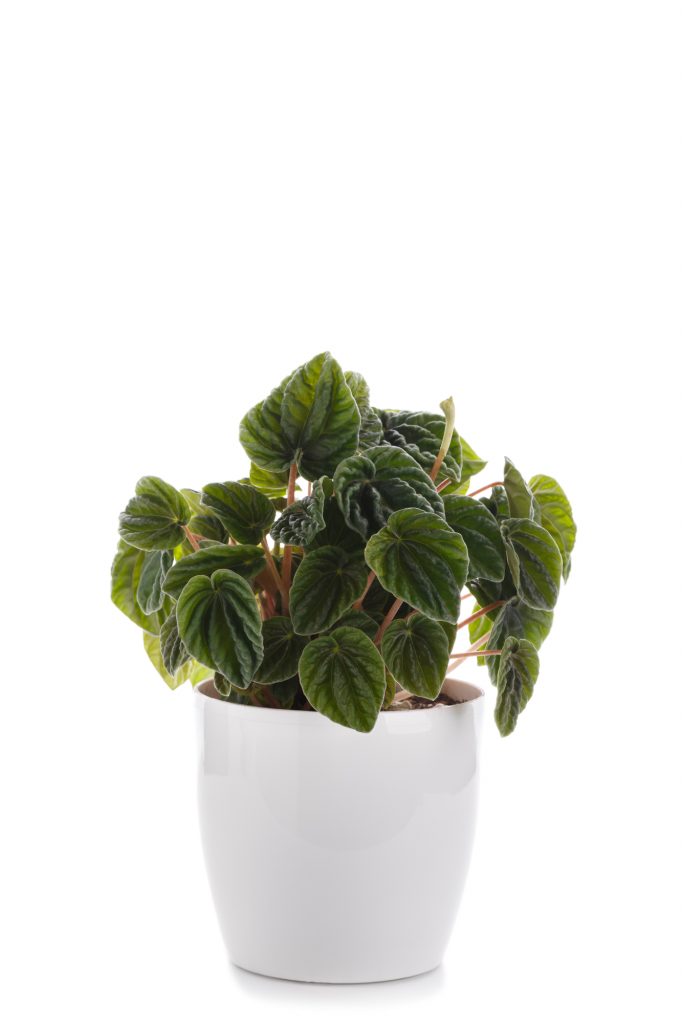Radiator plants (commonly known as peperomia) are trendy right now, probably because they’re easy to care for, safe for cats and dogs and come in many different varieties (my fave is the baby rubber plant).
They can even tolerate a bit of neglect, making them perfect for beginner plant parents. What’s attractive about the radiator plant is that they’re almost like the perfect mix between a succulent and a tropical plant. The leaves are fleshy and thick and the variegated species are stunning, like the watermelon peperomia.
Follow this guide to learn how to take care of your radiator plant.

This post contains affiliate links, which means I may make a small commission if you click through and make a purchase.
How Much Sunlight Does a Radiator Plant (Peperomia) Need?
Bright, indirect sunlight is the optimum amount of light the radiator plant needs to grow its best. Most varieties can handle brighter and full sun conditions as long it doesn’t get hot. They can develop sunburn if they’re getting scorched (brown spots on the middle of the leaves).
If you have a variegated peperomia, place them in a bright and sunny spot to help them keep their unique color patterns.
Peperomias will not grow well in low light conditions as the soil won’t dry out quick enough and the leaves need enough light to stay glossy and bright green.
A good way to remember how much sunlight peperomias need is to think of its nickname – the radiator plant – somewhere warm and cozy!
However, don’t let the name fool you. You don’t want to place peperomias (or any other plant) on or near a radiator.

How Often Do You Water a Peperomia Plant?
Water your peperomia plant when it is dry 2-3 inches down in the soil, which will be about every 2-3 weeks.
How do you know when a peperomia needs water? You can use the taco method! Only water when the leaves start to bend into a ‘u’ shape easily.
The leaves are quite thick compared to other houseplants, therefore it tends to need a little less water. It’s always better to under water your peperomia than to over water it. They also do well with bottom watering.
You can mist your peperomia about once a week, but I prefer to wipe the leaves down with a damp cloth instead. This gets rid of the dust and dampens the leaves slightly without the risk of adding too much moisture.

Signs of Over Watering Your Peperomia
Radiator plants are susceptible to root rot, so it’s important to not overwater them. If you happen to overwater your peperomia, you’ll start seeing little brown spots on the leaves.
If the leaves are falling off your peperomia, you’ve got a case of overwatering. It’s possible to fix a radiator plant that’s been overwatered by pulling it out of its pot and laying it out in a warm and sunny spot for a few days where it can dry out.
The Best Type of Pot and Soil for Peperomia Plant
Terracotta pots with drainage holes are the best type of pots to use for peperomias (or more houseplants).
Choose a shallow pot due to the small root system. Also, a smaller pot helps prevent overwatering.
You won’t need to repot your peperomia very often as they like to be nice and snug in their pot. If the roots haven’t started to grow out the bottom, you could repot after a few years to give it fresh soil.

I recommend using regular houseplant potting soil and mixing in some other substrate to help with drainage – this could be a combination of orchid media (bark ships, mulch, etc) and/or well-draining cactus soil.
You don’t want water to stick around and stay moist, so ensuring your soil mixture is fast draining will help your radiator plant live much longer.
How do You Propagate a Radiator Plant?
Radiator plants are one of the easiest types of houseplants to propagate. You can propagate a peperomia from either a leaf or a stem cutting with a high success rate. However, each variety prefers a different way to propagate.
Upright or trailing varieties of radiator plants will have the most success with propagation through stem cuttings, while bushy and compact types will grow best from leaf cuttings.

For stem cuttings, prune a stem that has 2 or 3 leaves on it, about 6 inches long with a few nodes or joints. Trim off any small leaves along the stem, and place in a jar of distilled water in a sunny spot.
It should start to grow roots in about 3-6 weeks at which point you can plant in the soil.
The glass jars in this propagation station are the perfect size for radiator plant cuttings.
To propagate radiator plants from leaves, you can simply stick leaves right into the soil to create a bushier plant. This is perfect when a few healthy leaves have dropped from moving or repotting.
For best results, pruning and propagating radiator plants is best done in the spring before growing season.
Common Problems with Radiator Plants (Peperomias)
Root rot will likely be the biggest culprit of a dying peperomia, which can be avoided by always being careful to not overwater it.
And just like any other houseplant, peperomias are also susceptible to pests like fungus gnats and mealybugs.
An insecticidal soap or the same methods to get rid of mealybugs should do the trick.
In the right conditions, radiator plants are fast growers, low maintenance and the perfect beginner plant!
Stay Green!


